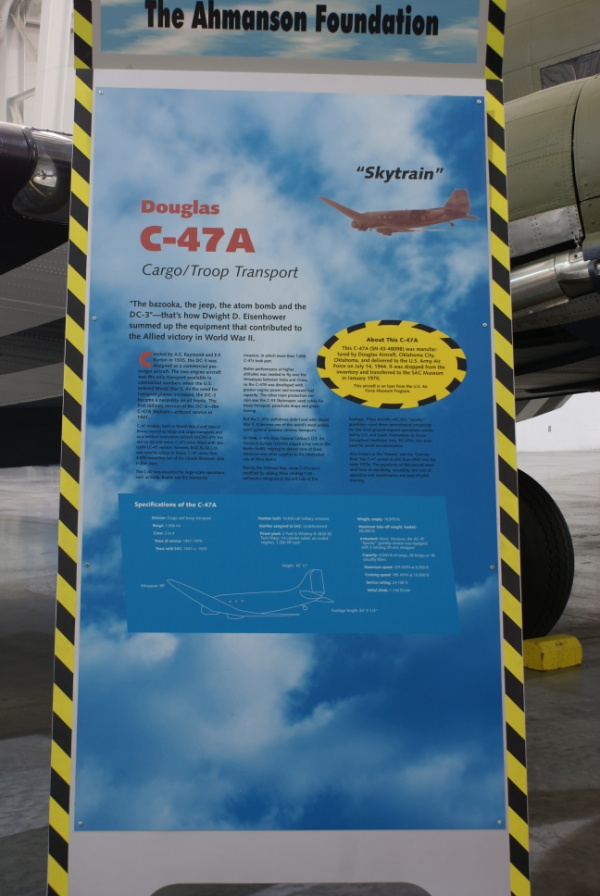| Prev |
heroicrelics.org Strategic Air Command & Aerospace Museum Site Index C-47 Gallery |
Next |
dsc60580.jpg
The sign accompanying the aircraft. It reads
"Skytrain"
Douglas
C-47A
Cargo/Troop Transport"The bazooka, the jeep, the atom bomb and the DC-3"–that's how Dwight D. Eisenhower summed up the equipment that contributed to the Allied victory in World War II.
Created by A.E. Raymond and E.F. Burton in 1935, the DC-3 was designed as a commercial passenger aircraft. The two-engine aircraft was the only transport available in substantial numbers when the U.S. entered World War II. As the need for transport planes increased, the DC-3 became a necessity on all fronts. The first military version of the DC-3–the C-47A Skytrain–entered service in 1941.
C-47 models, both in World War II and later in Korea, served as troop and cargo transports and as a medical evacuation aircraft (HC/SC-47). For use on ice and snow, C-47s were fitted with skis (USN LC-47 version, formerly R4D-5L/6L). In one notable action in Korea, C-47 crews flew 4,689 casualties out of the Chosin Reservoir area in five days.
The C-47 was essential for large-scale operations such as Sicily, Burma and the Normandy invasion, in which more than 1,000 C-47s took part.
Better performance at higher altitudes was needed to fly over the Himalayas between India and China, so the C-47B was developed with greater engine power and increased fuel capacity. The other main production version was the C-53 Skytrooper, used solely for troop transport, parachute drops and glider towing.
But the C-47's usefulness didn't end with World War II. It became one of the world's most widely used, general-purpose military transports.
In 1948, C-47s from General LeMay's U.S. Air Forces in Europe (USAFE) played a key role in the Berlin Airlift, helping to deliver tons of food, medicine and other supplies to the blockaded city of West Berlin.
During the Vietnam War, some C-47s were modified by adding three rotating 7.62-millimeter miniguns to the left side of the fuselage. These aircraft–AC-47 "Spooky" gunships–used these concentrated armaments for low-level ground-support operations conducted by the U.S. and South Vietnamese air forces throughout Southeast Asia. RC-47As were used for aerial reconnaissance.
Also known as the "Dakota" and the "Gooney Bird," the C-47 served in SAC from 1947 into the early 1970s. The popularity of this aircraft stemmed from its durability, versatility, low cost of operation and maintenance and ease of pilot training.
About This C-47A
This C-47A (SN 43-48098) was manufactured by Douglas Aircraft, Oklahoma City, Oklahoma, and delivered to the U.S. Army Air Force on July 14, 1944. It was dropped from the inventory and transferred to the SAC Museum in January 1970.
This aircraft is on loan from the U.S. Air Force Museum Program.
Specifications of the C-47A
Mission: Cargo and troop transport
Range: 1,500 mi
Crew: 2 to 4
Years of service: 1941-1975
Years with SAC: 1947-c. 1970
Number built: 10,926 (all military versions)
Number assigned to SAC: Undetermined
Power Plant: 2 Pratt & Whitney R-1830-92 Twin Wasp, 14-cylinder radial air-cooled engines, 1,200 HP each
Weight, empty: 16,970 lb
Maximum take-off weight, loaded: 26,000 lb
Armament: None. However, the AC-47 "Spooky" gunship version was equipped with 3 rotating 20-mm miniguns.
Capacity: 6,000 lb of cargo, 28 troops, or 18 casualty litters
Maximum speed: 229 MPH at 8,5000 ft
Cruising speed: 185 MPH at 10,000 ft
Service ceiling: 24,100 feet
Initial Climb: 1,130 ft/min
Height: 16', 11"
Wingspan: 95'
Fuselage length: 64' 5-1/2"

| Time picture taken | Fri Apr 17 12:26:44 2009 |
| Location picture taken |
Hangar B Strategic Air & Space Museum Ashland, NE |
| Prev |
heroicrelics.org Strategic Air Command & Aerospace Museum Site Index C-47 Gallery |
Next |